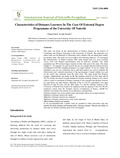| dc.contributor.author | Kembo, Jane | |
| dc.contributor.author | Omito, Ouma | |
| dc.date.accessioned | 2017-04-04T15:19:46Z | |
| dc.date.available | 2017-04-04T15:19:46Z | |
| dc.date.issued | 2015 | |
| dc.identifier.issn | 2310-4090 | |
| dc.identifier.uri | http://repository.rongovarsity.ac.ke/handle/123456789/636 | |
| dc.description.abstract | The study was based on the characteristics of distance learners at the School of Continuing and Distance Education at the University of Nairobi. The particular case under study was the Bachelor of Education (Arts) students who are taking their studies by distance mode. The study was set to achieve the following objective: To investigate the characteristics of distance learners. The study design used was cross sectional survey with well deigned questionnaires and an interview schedule. The study population was 500 external degree students in their final part of the study. The study sample of 217 students was arrived at by the use of a sample table provided by Krejcie
and Morgan (1970).The sampling technique was simple random. To test on validity and reliability a pre-test was conducted, that is split-half method was used to establish the effectiveness and internal consistency of the questionnaire. Content validity was used on the results and comments from the pilot study. The study found that distance learners‟ characteristics are varied. In the first instance, both 59 (51.3%) male and 56 (48.7%) female are almost in equal demand for distance learning. Gender is not a factor when it comes to enrolment in distance learning. It also emerged that distance learners are aged hence are adult learners. Majority of the 41 (35.7%) respondents were aged between 36 and 40 years. On the other hand, 111 (96.5%) distance learners at the
University of Nairobi were found to be employed with the majority of the 104 (90.4%) employees drawn from the Teachers Service Commission of Kenya. 102(88.7%) students were found to be married. It was therefore concluded that:
•Distance learners cuts across gender (male and female) almost on an equal measure
•Majority of distance learners are adults
•Majority of distance learners are employed
•Majority of distance learners have some work experience.
•Most distance learners are married
It was recommended that a similar study be extended to other universities and may include the adult teaching and learning styles. Distance learners‟ lifestyle and ability to meet the cost distance learning needs to be investigated. | en_US |
| dc.language.iso | en | en_US |
| dc.publisher | International journal of scientific footprints | en_US |
| dc.title | Characteristics of Distance Learners In The Case Of External Degree Programme of the University Of Nairobi | en_US |
| dc.type | Article | en_US |

